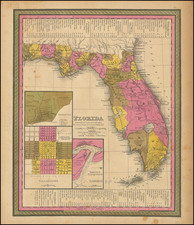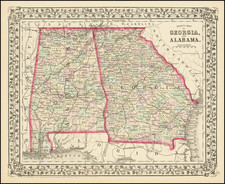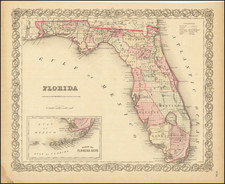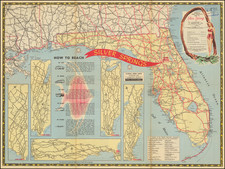A Revolutionary War Florida Rarity.
Finely colored example of the Depot de La Marine's set of coastal charts the area around Amelia Island and the mouth of the Nassau River, based upon surveys conducted under the direction of British Captain Jacob Blamey in January 1775 and by Gerard De Brahm and William Fuller.
The Amelia Island map is oriented with west at the top. On Amelia Island, the Countess Dowager of Egmont's Plantation is shown, along with Mount Misery, Morriss Bluff, "Negro Hutts and Indigo Works," and a beacon. The Ruins of Fort William, built by General Oglethorpe are shown on Cumberland Island. Woodland's Plantation, Bells Plantation and Ralphs Plantation are shown in East Florida at the top of the map, while Messr Wright's Plantation is shown in Georgia.
Across the top, the Plan of Amelian Island in East Florida showcases the natural deep harbor on the north end of Amelia Island, an important anchorage for all kinds of sailing vessels including smugglers, pirates, and slave ships. The plan of Amelia Island is noted as being taken from William De Brahm's monumental, large format map of South Carolina & Georgia, published in 1757.
At the bottom left, the Plan of the Bar and Entrance to the Nassau River is based on the surveys of Captain William Fuller and comes with an extensive notice for crossing the bar.
A prospective view of the entrance to St. Mary's River is inset at upper right. Dedicated to the Right Honorable John Earl of Egmont.
The sailing directions describe the approach to Amelia's Port, specifying the latitude and longitude from the Paris Meridian, and noting its relative position to the well-known harbors of St. Augustine and Georgia. The magnetic declination observed in January 1775, as well as the imperative of timing one's navigation with the tidal hours, underlines the detailed knowledge and preparation required for successful maritime endeavors of the era.
Practical advice is offered for anchoring outside the bar during low tide conditions and descriptions of the seabed composition are provided. The mention of the bar's condition being less hazardous than that of Charleston offers a comparative assessment of risks.
In the final paragraphs, detailed instructions are delineated for entering the South Channel, with landmarks such as a navigation marker on the northernmost dune and a distinctive cluster of trees serving as vital points of reference. Sailors are cautioned about the swift northward current during the flood tide and the southeastward pull of the ebb tide, emphasizing the need for vigilance and precision in steering. The concluding sentences guide the navigator through the North Channel, directing them to align with a prominent pine tree on the northern extremity of Tiger Island.
Rarity
The chart is quite scarce.
The Dépôt de la Marine, known more formally as the Dépôt des cartes et plans de la Marine, was the central charting institution of France. The centralization of hydrography in France began in earnest when Jean-Baptiste Colbert became First Minister of France in 1661. Under his watch, the first Royal School of Hydrography began operating, as did the first survey of France’s coasts (1670-1689). In 1680, Colbert consolidated various collections of charts and memoirs into a single assemblage, forming the core of sources for what would become the Dépôt.
The Dépôt itself began as the central deposit of charts for the French Navy. In 1720, the Navy consolidated its collection with those government materials covering the colonies, creating a single large repository of navigation. By 1737, the Dépôt was creating its own original charts and, from 1750, they participated in scientific expeditions to determine the accurate calculation of longitude.
In 1773, the Dépôt received a monopoly over the composition, production, and distribution of navigational materials, solidifying their place as the main producer of geographic knowledge in France. Dépôt-approved charts were distributed to official warehouses in port cities and sold by authorized merchants. The charts were of the highest quality, as many of France’s premier mapmakers worked at the Dépôt in the eighteenth century, including Philippe Bauche, Jacques-Nicolas Bellin, Rigobert Bonne, Jean Nicolas Buache, and Charles-François Beautemps-Beaupré.
The Dépôt continued to operate until 1886, when it became the Naval Hydrographic Service. In 1971, it changed names again, this time to the Naval and Oceanographic Service (SHOM). Although its name has changed, its purpose is largely the same, to provide high quality cartographic and scientific information to the France’s Navy and merchant marine.










![[North St. Peterburg News -- Tamiami Air Line and Flying Field]](https://storage.googleapis.com/raremaps/img/small/94319.jpg)



![[Florida Territory] North America XIV Florida](https://storage.googleapis.com/raremaps/img/small/95236.jpg)